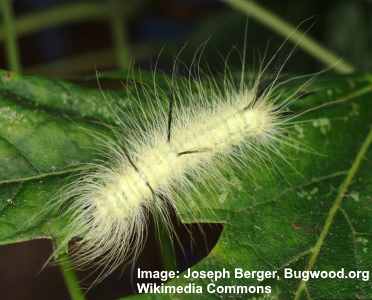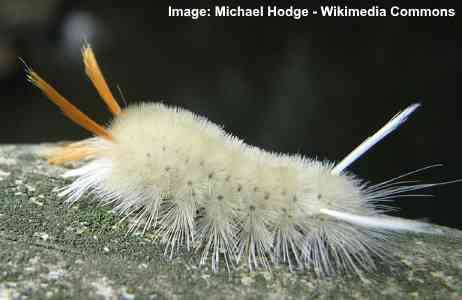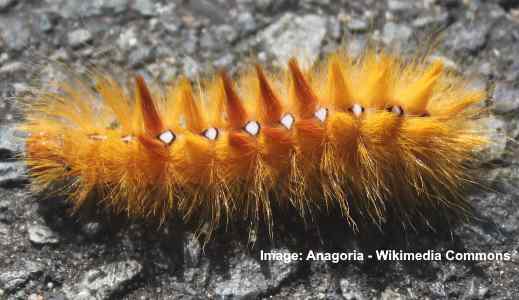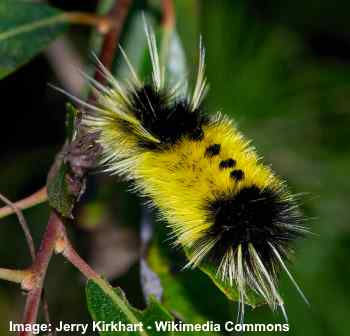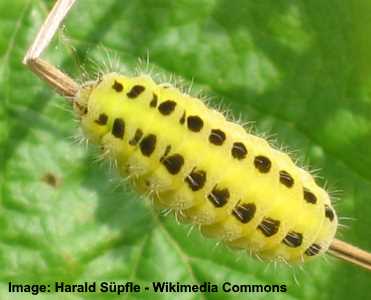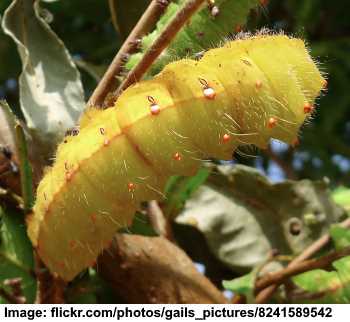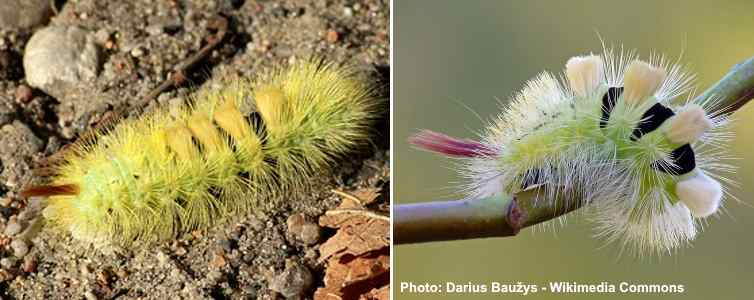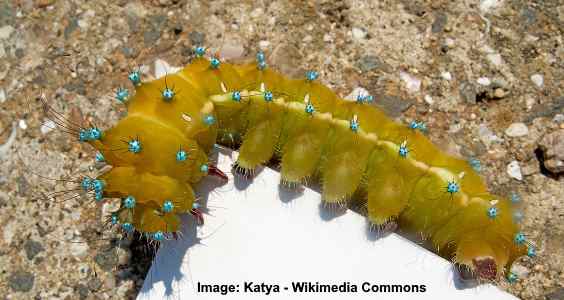27 Yellow Caterpillars with Identification Guide and Pictures
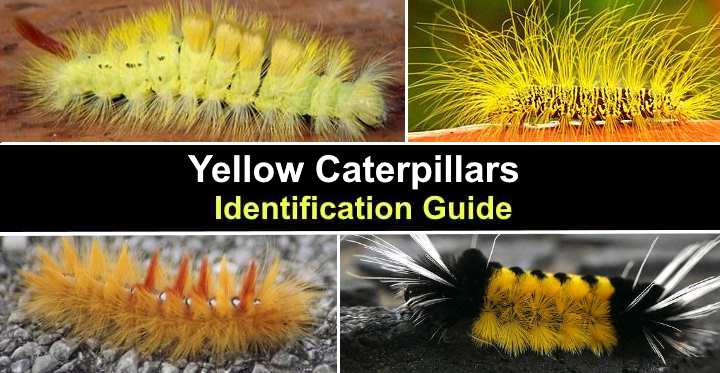
Yellow caterpillars are larvae that turn to stunning moths or butterflies. Some types of yellow caterpillars are fuzzy-looking and others have smooth segmented bodies typical of many species of caterpillars. Sometimes, yellow fuzzy caterpillars can be poisonous. Although they are not toxic enough to kill you, touching them can cause skin irritation.
All types of yellow caterpillars, as with all caterpillar species, belong to the order of insects called Lepidoptera. They generally look like fat slugs or worms, although some caterpillars have exotic spiky bodies. Caterpillars have a huge appetite and they eat through a lot of vegetation before they enter the pupal stage. After that, the insects reach their final stage and emerge as moths or butterflies.
When looking at pictures to identify caterpillars, it is good to remember that caterpillars go through 4 or 5 growth stages. So, an immature caterpillar may look completely different from one before it becomes a pupa.
Because caterpillars can’t defend themselves, they have various defense mechanisms to protect themselves from predators. Bright yellow and black caterpillars can appear unappetizing to other animals. Spiny bristles on some yellow caterpillars have venom that can cause irritation. Green caterpillars use camouflage to hide from birds and other animals.
In this article, you will learn about the most common types of yellow caterpillars. Along with pictures of caterpillars, descriptions and their scientific name will help identify species of yellow caterpillars.
Yellow Caterpillar Identification
It is easy to identify species of yellow caterpillars due to their yellowish coloring. Some fuzzy caterpillars are yellow due to the color of their spiny hairs (called setae). Other yellow caterpillars have yellow and black markings making them look like types of striped caterpillars.
Interestingly, from all the different species of caterpillars, most yellow caterpillars have spikes or hairs making them look furry. You may also notice that some fuzzy yellow caterpillars have large horns at either end of their bodies. It’s good to remember that most hairy yellow caterpillars can sting because of their urticating hairs.
Types of Yellow Caterpillars with Pictures: Identification Guide
Let’s look in more detail at the many different types of caterpillars that have yellow bodies or yellow hairs.
American Dagger Moth Caterpillar (Acronicta americana) – Yellow Fuzzy Caterpillar
The American dagger moth caterpillar is a fuzzy, yellow caterpillar with its body covered in yellow urticating hairs. This caterpillar is identified by tufts of bristly yellow hairs, a shiny oval black head, and long black spines that can grow to about 2 inches (5 cm) in length. As the caterpillar matures, its fuzzy yellow color turns to pale yellow or white.
The American dagger moth caterpillar doesn’t sting like a wasp. The irritating hairs break off in the skin where they can cause hives, welts, or dermatitis. So, to avoid getting “stung,” you shouldn’t pick up these fuzzy yellow caterpillars.
The American dagger moth caterpillars appear between July and October and live in deciduous forests and woodlands. They love to gorge on the leaves of maples, birch, hickory, oaks, and elms.
When these spiky yellow caterpillars become adults, they are a brown species of moth. These flying insects have a wingspan of up to 2.6” (6.5 cm) and have white, tan, and dark brown markings on their wings.
Yellow caterpillar identification
The American dagger moth caterpillar is easy to identify due to its fuzzy yellow appearance and black spines or spikes on its body. These black spikes are one of its identifying features, along with tufts of bristly yellow hairs and a shiny oval black head. These spikes, or urticating hairs, are not venomous but can cause skin irritation if touched.
- Adult Stage: It transforms into the dagger moth, a medium-sized moth.
- Caterpillar Feeds on: American dagger moth caterpillars feed on the leaves of various deciduous trees, including birch, maple, oak, and willow.
- Habitat: Found in Eastern North America, from Canada to Florida, often in woodlands, gardens, and urban areas.
- Stinging: The caterpillar has mildly irritating spines but does not cause severe stings.
Yellow Woolly Bear (Spilosoma virginica) – Yellow Fuzzy Caterpillar
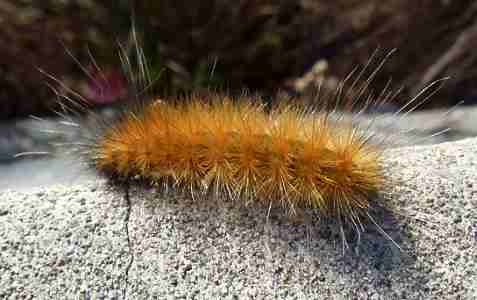
The yellow woolly bear is a common type of furry caterpillar
Yellow woolly bear caterpillars are fuzzy caterpillars that also have long, thin, spiky hairs. Although this species has the common name of yellow woolly bear, the fuzzy colors can range from white to yellow to reddish-brown. Yellow woolly bears are the most common type of fuzzy yellow caterpillar in North America.
You can identify yellow woolly bear caterpillars by their short bristles together with extra-long hairs. The most striking example of these caterpillars is the kind that is black and yellow with long pencil hairs. These crawling furry caterpillars can grow up to 2” (5 cm) and are generally found on low-growing plants.
Woolly bear caterpillars are not poisonous insects, but their setae are irritating and can cause dermatitis. You may find them munching their way through carrot, sweet potato, and eggplant leaves. So, if you are trying to get rid of these caterpillars from your garden, make sure and wear protective gloves.
After the yellow furry larvae go through metamorphosis, they turn into the Virginia tiger moth. This is a beautiful species of white moth with a wingspan of between 1.1” and 2” (3 – 5 cm).
The Yellow Woolly Bear caterpillar is native to the United States and can be found in various locations across North America, from Canada through northern Mexico.
Yellow caterpillar identification
You can identify yellow woolly bear caterpillars by their hairy appearance and longer pencil hairs.
- Adult Stage: Transforms into the Virginian tiger moth, a white moth with black spots.
- Caterpillar Feeds on: Yellow woolly bear caterpillars are known to feed on various plants, with a preference for dandelions and other low-growing vegetation.
- Habitat: Found throughout North America, including the United States and Canada, in a variety of habitats such as meadows, fields, and gardens.
- Stinging: Yellow woolly bear caterpillars are not known to sting humans.
Sycamore Tussock Moth Caterpillar (Halysidota harrisii) – Pale-Yellow Fuzzy Caterpillar
A member of the family of tiger moths, the sycamore tussock caterpillar is a pale-yellow fuzzy caterpillar with orange and white spiky hairs. As their name suggests, these yellow tussock caterpillars are found eating the foliage of sycamore trees. The small caterpillars only grow to about 1” (3 cm) in length.
To help with caterpillar identification, look for a pair of long orange pencil hairs at one end, and a pair of white pencil hairs at the other. You will also notice that its body is covered in light yellowish-white bristles.
As with most kinds of furry caterpillars, their urticating setae can cause skin inflammation when handled. Some medical reports show that exposure to sycamore tussock caterpillars can result in allergic reactions. (1)
After pupation, the sycamore tussock caterpillar emerges as a yellow moth with bluish wings. The sycamore moth has a plump short furry body and a wingspan of 2” (5 cm).
One way to control populations of these hungry caterpillars is to encourage birds to your garden who feed on the moths and larvae.
Yellow caterpillar identification
The identification of this yellow fluffy caterpillar is by the pair of orange spikes at its head end. Also, look for small black dots running the length of its sides as well as long pale-yellow bristles at its feet.
- Adult Stage: Develops into the sycamore moth, a white moth with black spots and orange markings.
- Caterpillar Feeds on: The caterpillar primarily feeds on sycamore, maple, and other tree leaves.
- Habitat: Native to Eastern North America, often found in deciduous forests, urban areas, gardens, and parks.
- Stinging: It possesses mildly irritating spines but does not deliver severe stings.
Sycamore Moth (Acronicta aceris)
The sycamore moth caterpillar is a hairy caterpillar that has orange and yellow bristles covering its short body. These insects are mainly found in Europe and the Middle East. The orange-yellow hairs on sycamore caterpillars are arranged in tufts along the length of its body.
The bright coloring of this caterpillar species makes it easy to identify. In addition to the tufts of orange/yellow hairs, there are white dots running down the middle of its back. Sometimes, these can be joined together by a white line. These long-haired yellow or orange caterpillars have black heads.
If you look at the scientific names, you will see that the sycamore moth is different from the sycamore tussock moth. Sycamore moths are from the family Noctuidae and tussocks are from the moth family Erebidae.
These furry caterpillars turn into small sycamore moths that have gray wings measuring 1.5” (4 cm) across.
Yellow caterpillar identification
Their distinctive appearance of thickly covered long yellow or orange hairs make these caterpillars easy to spot. Commonly found on types of trees such as maples, mulberries, and horse-chestnuts.
- Adult Stage: Transforms into the sycamore moth.
- Caterpillar Feeds on: Feeds on the leaves of sycamore and maple trees.
- Habitat: Found in North America, particularly in the Eastern United States, often in wooded areas, parks, and gardens.
- Stinging: Sycamore Moth caterpillars are not known to sting.
Yellow Spotted Tussock Moth Caterpillar (Lophocampa maculata)
The yellow-spotted tussock caterpillar is another striking example of a yellow fuzzy caterpillar with black tufts of hair.
Looking at pictures of this spotted caterpillar, it is easy to see how it got its common name. Short tufts of yellow hairs cover its body and there are clumps of jet-black hairs running the length of its back. This gives the furry caterpillar a distinctive spotted appearance.
You will also see longer white pencil hairs sticking out at its feet and also at either end of its body. Other types of tussock moth caterpillars are black and yellow varieties. They have thick clumps of black irritating hairs at both ends and a thick wide yellow band around their middle. The long spiky white hairs from either end just add to its striking appearance.
Researchers from the University of Wisconsin say that these yellow caterpillars are found feeding in deciduous woodlands. They gorge on poplar, oak, willow, alder and maple leaves. Their coloration and urticating hairs act as a defense against birds. (2)
After emerging from the chrysalis, yellow spotted caterpillars are a type of tiger moth with elongated wings. The moth has lightly colored brown wings with irregular darker patterns.
Yellow caterpillar identification
The contrast of striking bright yellow hairs and tufts of pitch-black hairs are identifying features of spotted tussock moth caterpillars.
- Adult Stage: Becomes the spotted tussock moth.
- Caterpillar Feeds on: Feeds on various deciduous tree leaves.
- Habitat: Native to North America, including the United States and Canada, often in wooded areas, gardens, and parks.
- Stinging: Possesses mildly irritating spines but typically does not deliver severe stings.
Cloudless Sulfur (Phoebis sennae)
The cloudless sulfur caterpillar is a smooth-bodied yellow caterpillar with no hairs at all. As the larvae grow, they become a deep yellow color with some having a greenish appearance.
You will notice that these yellow caterpillars have green or dark bands in between some of the segments. If you look up closely, you will also see small black dots that are tiny spikes. Indentations running around its body give the appearance of stripes. Because of the lack of hairs, you can also clearly see the prolegs in the middle segments.
The green species of these caterpillars have a yellow line running the length of their bodies. Both the yellow caterpillars and the green caterpillars grow to about 1.8” (4.5 cm) in length.
Although their yellow color makes cloudless sulfur caterpillars stand out, they usually spend their days hiding and sleeping under leaves. They usually come out to feed at night when they gorge their way through leaves on clover and legume plant leaves.
After pupation, cloudless sulfurs turn into large beautiful yellow butterflies.
Yellow caterpillar identification
Bright yellow colors and thin green or dark stripes help identify this nocturnal caterpillar.
- Adult Stage: Transforms into the cloudless sulfur butterfly.
- Caterpillar Feeds on: Feeds on various species of leguminous plants, particularly those in the pea family.
- Habitat: Found throughout the Americas, including North and South America, often in open areas, gardens, fields, and coastal regions.
- Stinging: Cloudless sulfur caterpillars do not possess stinging spines.
Six-Spot Burnet (Zygaena filipendulae)
Another yellow caterpillar that looks like a fat slug is the six-spot burnet.
This plump yellow caterpillar goes through various growth stages where it can be pale green with black spots. As it matures, the portly caterpillar has a bright yellow body with black markings. Looking up closely at pictures of the caterpillar, you will also notice tiny fine hairs on its yellow body.
The bright yellow colors contrasting with black spots help to ward off predators that see the caterpillar as easy pickings. If birds do eat this caterpillar, they are in for a nasty surprise as the caterpillar produces poison cyanide that can be lethal.
The common name for this moth comes from the 3 pairs of red spots on the black wings of the adult. This is also a small species of moth with its wingspans being only 1.6” (4 cm) across.
Yellow caterpillar identification
The identification features of the six-spotted burnet caterpillar are its bright yellow body, black markings along its back, a light green stripe on its sides and thin spiny hairs.
- Adult Stage: Develops into the six-spot burnet moth.
- Caterpillar Feeds on: Feeds on a variety of plants, particularly those in the rose family such as bird’s-foot trefoil.
- Habitat: Common in Europe, including the United Kingdom, often in meadows, grasslands, and open habitats.
- Stinging: Six-spot burnet caterpillars do not have stinging spines.
Tasar Silkworm Caterpillar (Antheraea mylitta)
The tasar silkworm caterpillar is native to India and is also yellow in some of its growth stages.
This is a wild type of silkworm that produces high-quality durable silk. According to studies on the silk, these caterpillars produce stronger silk than the domestic silkworm (Bombyx mori) produces. (3)
What does this yellow species of this caterpillar look like? Its body is fat and plump and the segmented sections are clearly seen. There are short fine white hairs covering the body and you will notice white and red dots around the segments.
After the fat caterpillar emerges from its metamorphosis, it is a stunning type of moth. The silkworm moth has orange or brown wings with a white eye-like dot on each wing.
- Adult Stage: Transforms into the tasar moth.
- Caterpillar Feeds on: Feeds on the leaves of various trees, including oak, sal, and arjun.
- Habitat: Native to India, particularly in the tropical and subtropical regions, often in forests and orchards.
- Stinging: Tasar silkworm caterpillars do not possess stinging spines.
Pale Tussock (Calliteara pudibunda)
The common identifying feature of most tussock caterpillars is their fuzzy appearance.
The pale tussock has clumps of lemon-yellow and white hairs covering its body. The tufts of yellow hairs are on the back and white ones on the lower parts above the feet. This species of tussock is identified by the 4 thick tufts of bright yellow hairs on its back segments.
You can often find hairy pale-yellow tussock caterpillars munching their way through willow, birch, and oak leaves.
Yellow caterpillar identification
The main identifying feature of the pale tussock is clumps of bright yellow hairs. There are also black bands separating the yellow segments and red or brown fine hairs near the end section.
- Adult Stage: Becomes the pale tussock moth.
- Caterpillar Feeds on: Feeds on the leaves of deciduous trees and shrubs, including oak, willow, and birch.
- Habitat: Found in Europe, including the United Kingdom, often in woodlands, gardens, and urban areas.
- Stinging: Pale tussock caterpillars do not deliver stings.
Giant Peacock Moth Caterpillar (Saturnia pyri)
One of the most unusual crawling insects on this list of yellow caterpillars is the giant peacock species. Both the caterpillar and moth are huge insects.
Like many caterpillars, giant peacocks go through a number of growth stages where they change color. After hatching from eggs, the larvae are dark, almost black in color. In time they change to a dark yellow color before turning golden green. You will notice light blue dots called tubercles around the segments. Each tubercle has tiny stinging spikes that cause a lot of skin irritation.
Before they turn into pupas, these large caterpillars grow to nearly 5” (12 cm). When they emerge as brown moths, they are the biggest species of moth in Europe. Their wingspan is a massive 6” to 8” (15 – 20 cm). Their dark gray to brown wings have large eye markings to help confuse predators.
Yellow caterpillar identification
A large golden-green caterpillar with darker orange bands around the middle of the segments and turquoise-blue tubercles and tiny irritating hairs.
- Adult Stage: Transforms into the giant peacock moth, one of the largest moths in Europe.
- Caterpillar Feeds on: Feeds on the leaves of various fruit trees, such as pear and apple.
- Habitat: Native to parts of Europe, often in orchards and gardens.
- Stinging: Giant peacock moth caterpillars do not possess stinging spines.
Yellow Fuzzy Spotted Apatelodes (Apatelodes torrefacta)
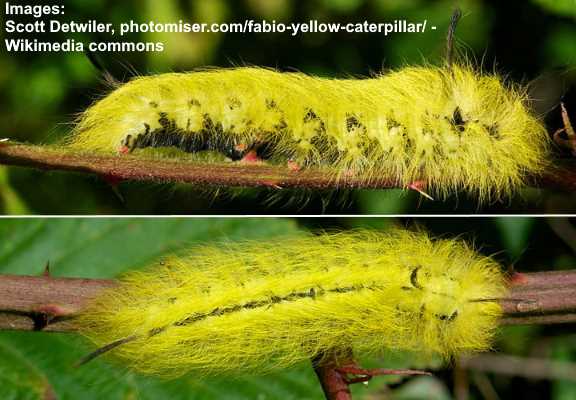
The fuzzy spotted apatelodes caterpillar starts as a furry white caterpillar and turns into bright yellow caterpillar
The spotted apatelodes is a hairy, brightly-colored yellow caterpillar covered in wispy hairs. This neon yellow crawling insect also has distinctive black lashes projecting from its head and tail end. Pictures of this hair-covered caterpillar show a black underside, a black line along its back, and black chevrons along its yellow body. It also has bright red prolegs.
The yellow spotted apatelodes measures 1.77” (45 mm) long. You will often find the fuzzy moth larvae feeding on oak, maple, and ash tree leaves. And their bright yellow color and furry appearance make them easy to spot on leaves.
As with many species of caterpillar, the spotted apatelodes undergoes several growth stages. The young, immature caterpillars have long, fine hairs and are entirely white with pinkish legs. As the bugs mature, they develop more vibrant coloring until they are neon yellow.
Yellow caterpillar identification
The spotted apatelodes moth caterpillar is a bright yellow hairy caterpillar with a thin black stripe on its back, black spots along its sides, and tufts of black hair at either end.
- Adult Stage: Develops into the spotted apatelodes moth.
- Caterpillar Feeds on: Feeds on various deciduous tree leaves.
- Habitat: Found in parts of North America, often in forests, woodlands, and gardens.
- Stinging: Yellow fuzzy spotted apatelodes caterpillars do not typically sting.
White-Marked Tussock Moth Caterpillar (Orgyia leucostigma)
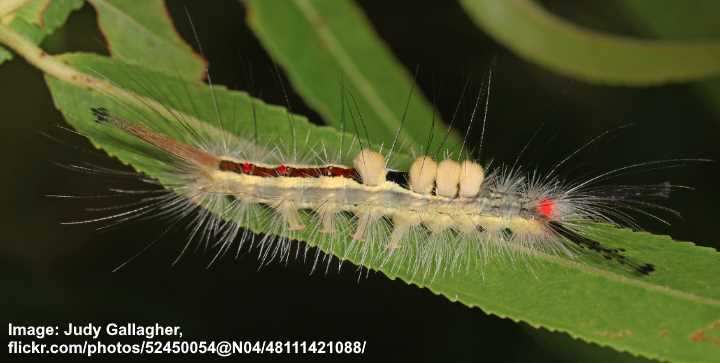
The furry white-marked tussock caterpillar is easily identified by its unique look with 4 tufts of pale yellow hairs
The white-marked tussock caterpillar is a brightly colored insect with yellow stripes along its black body. Unusual features of this caterpillar are its four toothbrush-like tufts of yellowish hairs, bright red spots, and long pencil hairs protruding from either end. In addition, tufts of long setae stick out along the caterpillar’s body.
This yellow and black caterpillar grows 1.37” (35 mm) long. Larvae of the white-marked tussock moth feed on a variety of deciduous and coniferous trees. You will find the light-colored caterpillars on maple, birch, basswood, sycamore, apple, and elm trees. And the destructive pests skeletonize leaves and can defoliate entire trees.
This hairy yellow caterpillar is commonly found in the eastern United States and as far west as Texas. A native Texas caterpillar is the subspecies Orgyia leucostigma.
It’s also noted that this is a yellow stinging caterpillar, and the urticating hairs can cause allergic skin reactions.
Yellow caterpillar identification
The easy-to-recognize white-marked tussock moth caterpillar has four dense tufts of pale-yellow hairs on its back and bright yellow stripes along its body.
- Adult Stage: Transforms into the white-marked tussock moth.
- Caterpillar Feeds on: Feeds on the leaves of various trees and shrubs.
- Habitat: Native to North America, often in forests, woodlands, and urban areas.
- Stinging: White-marked tussock moth caterpillars possess mildly irritating spines but do not deliver severe stings.
Silver-Spotted Skipper Caterpillar (Epargyreus clarus)
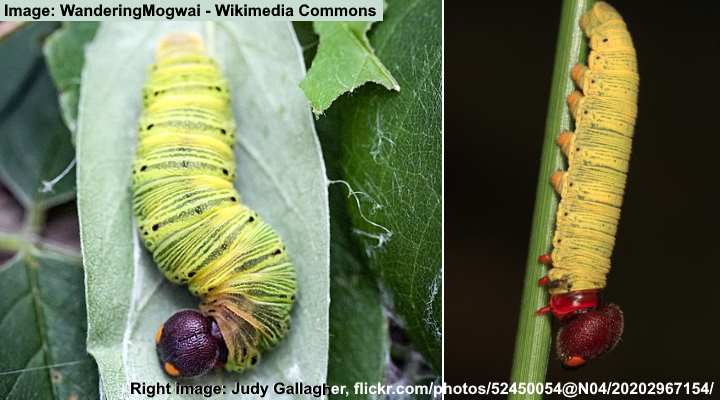
The silver-spotted skipper is a yellow-green caterpillar with brown rounded head and two orange eyespots
The silver-spotted skipper butterfly larva is a yellowish-green caterpillar with a reddish-brown globular head and two conspicuous yellow or orange eyespots. Identifying features of this yellow slug-like bug are thin dark lines traversing its body and four pairs of orange prolegs. The bright yellow caterpillar grows 2” (50 mm) in length.
The stout yellow caterpillars feed on various legume plants in the pea family Fabaceae, black locust trees, and wisteria plants. The yellowish caterpillars are poisonous to other insects, birds, and small animals that try to eat them. They produce a bitter-tasting, greenish liquid when disturbed.
Yellow caterpillar identification
Identifying features of the yellow silver-spotted skipper caterpillar is its plump yellowish-green body with thin stripes and dots around its segments. In addition, it has a conspicuous round red-brown head capsule and two big orange spots.
- Adult Stage: Becomes the silver-spotted skipper butterfly.
- Caterpillar Feeds on: Feeds on the leaves of leguminous plants, including wisteria and beans.
- Habitat: Found in North and Central America, often in open areas, meadows, and gardens.
- Stinging: Silver-spotted skipper caterpillars do not possess stinging spines.
Cinnabar Moth Caterpillar (Tyria jacobaeae)

The cinnabar moth caterpillar has yellow and black stripes with fine hairs on its body
The cinnabar moth larva is a striking yellow caterpillar with glossy black bands traversing its segments. This yellow and black striped larva also has a sparse covering of fine spines. Some species of these caterpillars can be orange and black. The cinnabar caterpillar grows up to 1.2” (30 mm) long.
The cinnabar moth caterpillar feeds on ragwort plants, and they absorb toxic substances. These make the yellow caterpillars poisonous to most birds, besides cuckoos that eat hairy and toxic caterpillars.
After emerging from the pupa, the yellow and black larva turns into a stunning moth with pinkish-red and charcoal-black wings.
Yellow caterpillar identification
The striped yellow and black cinnabar moth caterpillar is easily recognizable due to its vibrant, contrasting colors.
- Adult Stage: Transforms into the cinnabar moth.
- Caterpillar Feeds on: Feeds on ragwort plants (Senecio species).
- Habitat: Common in Europe, often in grasslands, meadows, and areas with ragwort plants.
- Stinging: Cinnabar moth caterpillars do not have stinging spines.
Grapeleaf Skeletonizer Caterpillar (Harrisina americana)
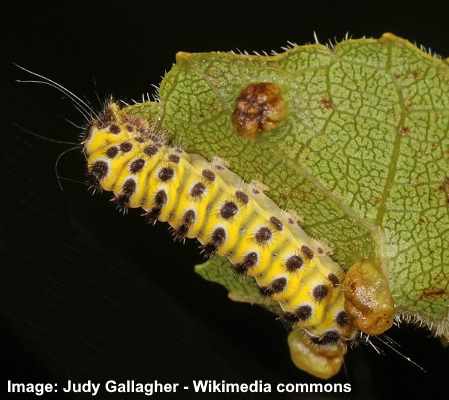
The grapeleaf skeletonizer caterpillar has yellow body with black dots and small irritating hairs
The grapeleaf skeletonizer larva is a cigar-shaped yellow caterpillar with bands of black spots or stripes around its segments. Pictures of the yellow caterpillar show a row of tufts along its side — these become more prominent as the caterpillar matures. The stout yellow larvae measure up to 0.59” (15 mm) long.
Although not classed as a dangerous caterpillar, the grapeleaf skeletonizer caterpillar has tufts of irritating hairs. These setae can cause a nasty skin rash lasting several days if you handle the yellow caterpillars.
As their name suggests, the grapeleaf skeletonizer caterpillar feeds on grape plants and can completely defoliate them. The yellow and black caterpillars are usually found underneath the leaves, so they are hard to notice before you spot the foliage damage.
A unique feature of the black spotted yellow caterpillars is that they are the only species that target grape plants.
Yellow caterpillar identification
To identify the grape leaf skeletonizer, look for its bright yellow body and bands of black spots around each of its segments.
- Adult Stage: Develops into the grapeleaf skeletonizer moth.
- Caterpillar Feeds on: Feeds on grapevine leaves and other plant species.
- Habitat: Found in North America, particularly in vineyards and areas with grapevines.
- Stinging: Grapeleaf skeletonizer caterpillars do not typically sting.
Redhumped Caterpillar (Schizura concinna)
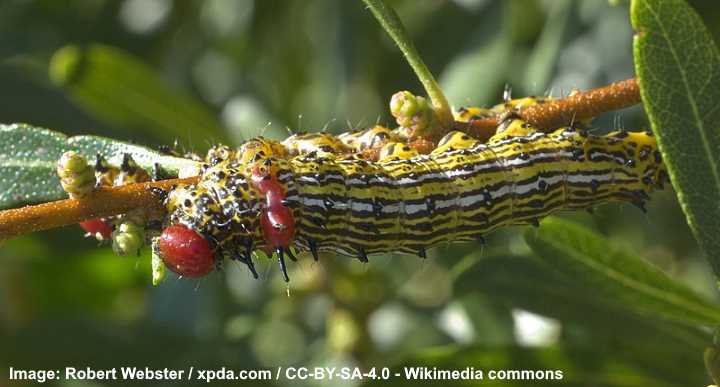
The attractive-looking redhumped caterpillar has yellow, black and white striped body with red head
Redhumped caterpillars have yellow bodies with black and white longitudinal stripes and bands of black fleshy spines around their segments. As the caterpillar matures, its black head becomes bright red, developing characteristic red bumps on its third segment. The redhumped caterpillar grows 1” to 1.5” (25 – 38 mm) long.
Redhumped caterpillars skeletonize foliage on trees such as walnut, willow, cottonwood, and various species of fruit trees. The striped, yellow caterpillars are active in April and May. However, a second generation can appear in mid-summer.
After pupating, the redhumped caterpillar turns into a brown moth that has reddish and white patterns on its wings.
Yellow caterpillar identification
The yellow redhumped caterpillar can be identified by its black and white bands running the length of its body, black fleshy spines, a red head, and conspicuous red humps near its head.
- Adult Stage: Becomes a small, inconspicuous moth.
- Caterpillar Feeds on: Feeds on the leaves of various deciduous trees and shrubs.
- Habitat: Native to North America, often in forests, woodlands, and gardens.
- Stinging: Redhumped caterpillar may have mildly irritating spines, but they are not known for severe stings.
Large Cabbage White Caterpillar (Pieris brassicae)
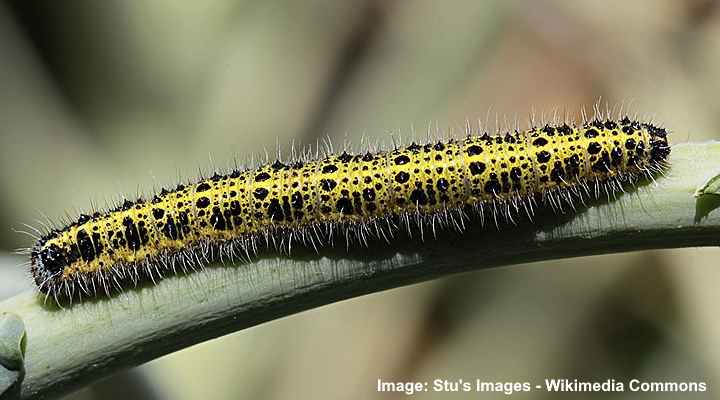
The large cabbage white caterpillar has a yellow body covered in black spots and fine hairs
The large cabbage white larva is a dark yellow caterpillar covered in black spots, fine setae, and black tubercles. The caterpillar starts life pale yellow with a distinctive brown head. It then becomes a darker yellow during the following instars. It then turns a grayish green and black before pupating.
The yellow and black cabbage butterfly caterpillar grows up to 1.57” (40 mm) long by its final growth stage. During this time, the yellowish-green caterpillars cause significant damage to cabbage and other plants in the genus Brassica. In some cases, the destructive pests can cause complete loss of crops.
Also called cabbage worms, the long slug-like pests turn into spectacular white butterflies. These attractive flying insects have white wings with brown margins and two brown spots on each forewing.
Yellow caterpillar identification
The large cabbage white butterfly caterpillar is identified by its yellowish-green body, irregular black spots, black head, and covering of white spiny setae.
- Adult Stage: Transforms into the large cabbage white butterfly.
- Caterpillar Feeds on: Various plants, especially those in the cabbage family (Brassicaceae).
- Habitat: Found in Europe, Asia, and North Africa, often in gardens and open areas.
- Stinging: Large cabbage white caterpillars do not have stinging spines.
Magpie Moth Caterpillar (Abraxas grossulariata)
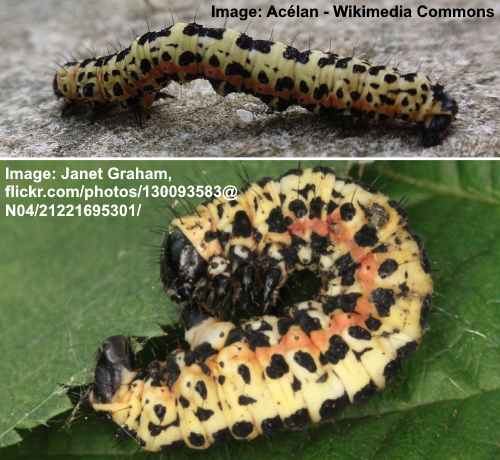
The magpie moth caterpillar can be identified by its pale yellow body, black spots and orange stripe on its sides
The magpie moth larva is a pale-yellow caterpillar with an orange stripe along its sides and a band of black spots along its body. Up close, pictures of this yellow and black caterpillar show fine setae on its body along with white markings, a black head, and black prolegs.
The magpie moth caterpillar is long and slender and grows up to 1.18” (30 mm). This distinctive creamy-yellow insect has a looping action like a cabbage looper as it moves along plant stems and foliage.
The black-spotted, pale-yellow caterpillar is active in April and May. You will find the looping caterpillar on many deciduous trees, including hawthorn, hazel, and blackthorn, as well as various blackcurrant and redcurrant shrubs.
Yellow caterpillar identification
The striking magpie moth caterpillar is identified by its creamy yellowish-white body, rows of black and white dots in irregular patterns, and orange stripes along its sides.
- Adult Stage: Develops into the magpie moth.
- Caterpillar Feeds on: Consumes the leaves of various shrubs and trees.
- Habitat: Common in Europe and parts of Asia, often found in woodlands and gardens.
- Stinging: Magpie Moth caterpillars do not possess stinging spines.
White-Lined Sphinx Moth Caterpillar (Hyles lineata)
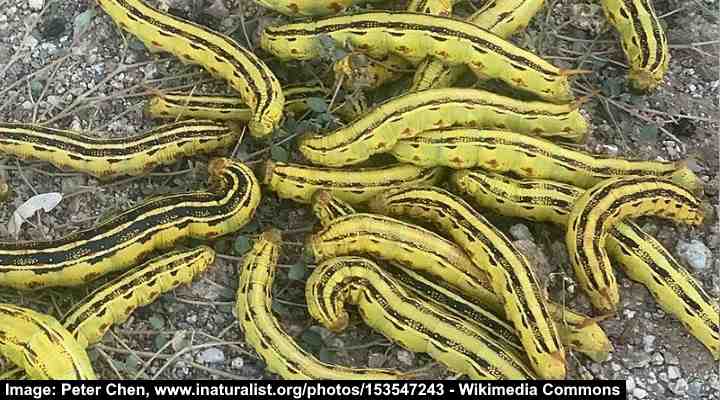
The white-lined sphinx caterpillar has many color variations depending on its growth stage, and can have a yellow body with black stripes lengthwise
The white-lined sphinx moth larva is an unusual caterpillar because there is wide color variation. The species with yellow variation is a sizable slug-like insect with a yellowish-green to dark yellow body and two prominent lengthwise black stripes. The yellow caterpillars also have brown spots along their sides, a brown head, and a conspicuous orange tail.
The huge cylindrical yellow caterpillars can grow up to 3.5” (88 mm) long. In some climates, the caterpillars can be lime green with an orange or black tail spike. In other places, the sizable larvae can be dark green with black and white spots.
The yellowish striped caterpillars feed on plants like tomato, apple tree foliage, elm, willow weed, purslane, and fuchsia. After pupating, the caterpillars turn into beautiful brown and pink moths —one of North America’s most abundant species of hawk moth.
Yellow caterpillar identification
The white-lined sphinx moth caterpillar is identified by a yellowish-green slender body, black stripes along its back, an orange or pale brown tail, and brown and black markings along its sides.
- Adult Stage: Transforms into the white-lined sphinx moth.
- Caterpillar Feeds on: Feeds on a variety of plants, including members of the potato family (Solanaceae).
- Habitat: Found throughout North and Central America, often in open areas, deserts, and gardens.
- Stinging: White-lined sphinx moth caterpillars do not typically sting.
Grass Eggar Moth Caterpillar (Lasiocampa trifolii)
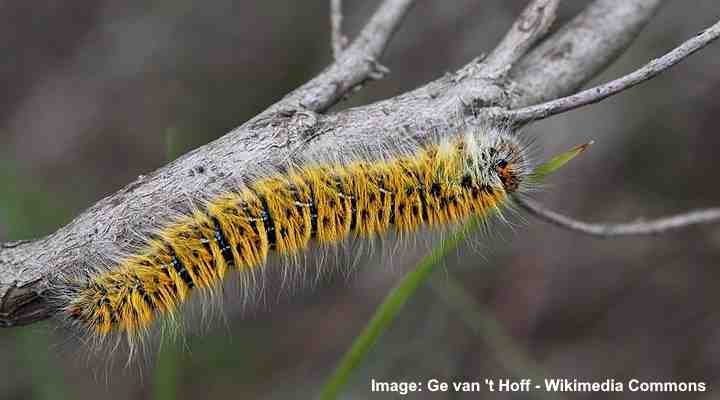
The long black body of the grass eggar moth caterpillar is covered with furry coat of yellow-orange hairs
The grass eggar moth larva is a black caterpillar that appears orange-yellow due to its heavy coating of pale-yellow to orange-brown hairs. The long, slender, hairy caterpillar has varying color combinations. Some species are bright yellow and black, whereas others appear to have yellowish hairs on their sides and an orange band along their backs.
The large hairy caterpillar grows up to 2.55” (65 mm) long and is full size by mid-June. You will find the caterpillars feeding on the leaves of deciduous trees and shrubs, like oak, beech, and willow. But, as its name suggests, it also feeds on various types of grasses.
Yellow caterpillar identification
The grass eggar caterpillar is identified by its dense covering of fine hairs on its black body. However, it can be tricky to identify as not all species have bright yellow or dull yellow hairs, which some Lasiocampa trifolii caterpillars show.
- Adult Stage: Becomes the grass eggar moth.
- Caterpillar Feeds on: Feeds on various grasses and low vegetation.
- Habitat: Native to Europe and parts of Asia, often in grasslands and meadows.
- Stinging: Grass eggar moth caterpillars do not have stinging spines.
African Death’s-Head Hawkmoth (Acherontia Atropos)
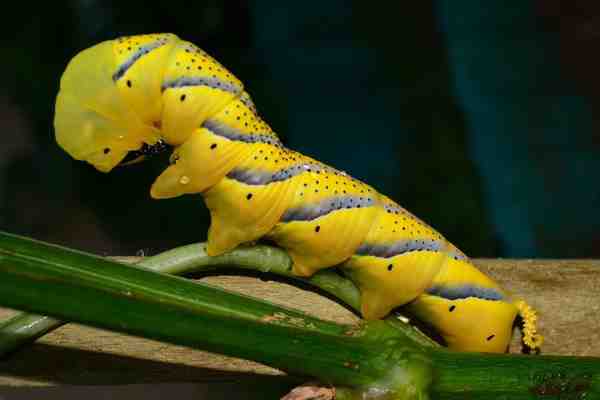
The huge African death’s-head hawkmoth caterpillar has a bright yellow body with diagonal gray stripes and black dots
The African death’s-head hawkmoth larva is a giant bright yellow caterpillar that looks like a yellow tobacco hornworm. The golden yellow caterpillar has distinctive diagonal grayish stripes along its sides, a prominent spot at the base of each segment, black speckles covering its back, and six tiny legs at its head.
A distinctive feature of this yellow hawkmoth caterpillar is its posterior horn covered in tiny projections. On some caterpillars, the horn curls round and points upward.
The smooth, glossy, yellow caterpillar grows to 6” (150 mm) long. It is harmless to humans, apart from the damage it can do to plants. Host plants of this large, stout yellow caterpillar include potato and other plants in the nightshade family, lantana, olive trees, and hemp plants.
After pupating, the enormous yellow larva turns into a stunning brown and yellow moth. It gets its name from the skull-shaped pattern near the moth’s head.
Yellow caterpillar identification
The African death’s-head hawkmoth is easy to identify due to its bright enormous yellow body, diagonal grayish stripes and spotted back.
- Adult Stage: Develops into the African death’s-head hawkmoth, known for its distinctive skull-like markings on its thorax.
- Caterpillar Feeds on: Consumes various plants, including nightshades (Solanaceae).
- Habitat: Native to Africa, Europe, and parts of Asia, often found in diverse habitats.
- Stinging: African death’s-head hawkmoth caterpillars may have mildly irritating spines but are not known for severe stings.
Marbled Yellow Pearl Moth Caterpillar (Evergestis extimalis)
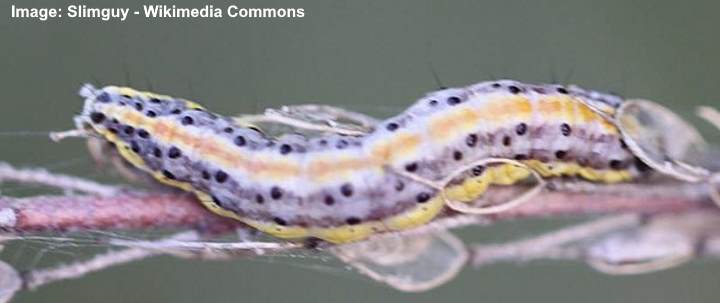
The marbled yellow pearl moth caterpillar has a yellow, white and gray striped body with black dots
The larva of the marbled yellow pearl moth is a brightly colored yellow caterpillar with rows of black dots along its back. This striped caterpillar can have pale gray, white, and orange stripes running lengthwise on its body. The colorful caterpillar also has fine black spiny hairs and a rounded head.
The marbled yellow pearl caterpillars tend to feed on cruciferous plants in the family Brassicaceae. After pupating, the striped yellow caterpillar turns into an attractive moth with pale whitish-gray and brown wings with several brown dots and pale orange markings.
Yellow caterpillar identification
The marbled yellow pearl moth caterpillar is a colorful yellow caterpillar, identified by its orange, pale gray, and white longitudinal stripes and lines of black dots.
- Adult Stage: Transforms into the marbled yellow pearl moth.
- Caterpillar Feeds on: Feeds on cruciferous plants, including mustard and cabbage.
- Habitat: Found in North America, often in gardens, fields, and agricultural areas.
- Stinging: Marbled yellow pearl moth caterpillars do not typically sting.
Tomato Moth Caterpillar (Lacanobia oleracea)
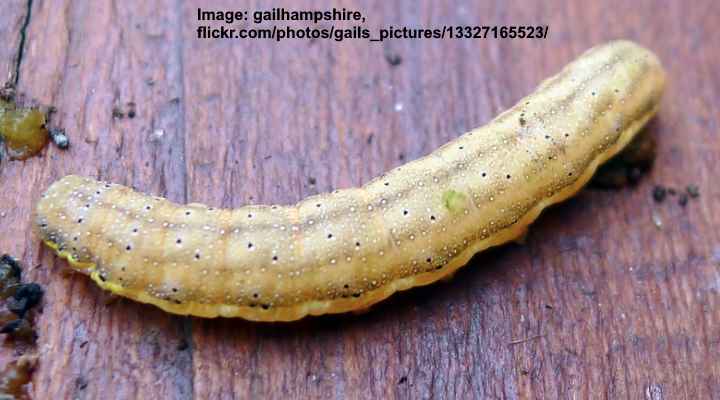
The tomato moth caterpillar has several variations, among them a pale yellow body covered with faint darker lines and black and white spots
Some tomato moth caterpillars appear as pale-yellow slug-like insects with faint tan stripes and black and white dots. However, the caterpillars can develop shades of brown, with the lightest varieties appearing as light yellow to tan. However, some species can be deep brown with a conspicuous yellow stripe along their sides.
Also called the bright-line brown-eye moth, a distinctive feature of the plump caterpillars is the sprinkling of brown to black specks. In the darker varieties, these tiny dots appear white.
Tomato moth caterpillars grow up to 1.57” (40 mm) long. They are not considered pests because they typically feed on garden weeds like dandelion, plantain, dock, and water mint. However, they can become a pest in greenhouses where they like to feed on tomato plants and fruit.
Yellow caterpillar identification
The tomato moth caterpillar is identified by its cylindrical body in various shades of brown — from yellowish-tan to dark greenish-brown. Its identifying features are small black and white dots and darker faint lines running along its body.
- Adult Stage: Develops into a moth species of the family Noctuidae.
- Caterpillar Feeds on: Feeds on various plants, including tomato plants.
- Habitat: Common in Europe, often in gardens and agricultural areas.
- Stinging: Tomato moth caterpillars do not possess stinging spines.
Zebra Caterpillar (Melanchra picta)
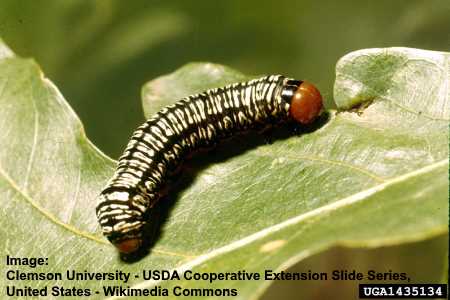
The black and yellow striped zebra caterpillar can be identified by its reddish-brown head
The zebra caterpillar is a striking caterpillar due to its bands of yellow and black running lengthwise. The zebra-like patterns create a distinctive appearance with solid black lines along its side. Additionally, the zebra caterpillar has a rounded reddish-brown head and underside. This unusual caterpillar grows 1.4” to 1.6” (35 – 40 mm) long.
Yellow caterpillar identification
The zebra caterpillar is easy to identify due to its conspicuous bright yellow zebra-like markings and black bands along its back and sides.
- Adult Stage: Develops into the American noctuid moth.
- Caterpillar Feeds on: Consumes a variety of plants, including grasses and clover.
- Habitat: Found in North America, often in grassy areas, meadows, and gardens.
- Stinging: Zebra caterpillar larvae do not typically possess stinging spines.
Mullein Moth Caterpillar (Cucullia verbasci)
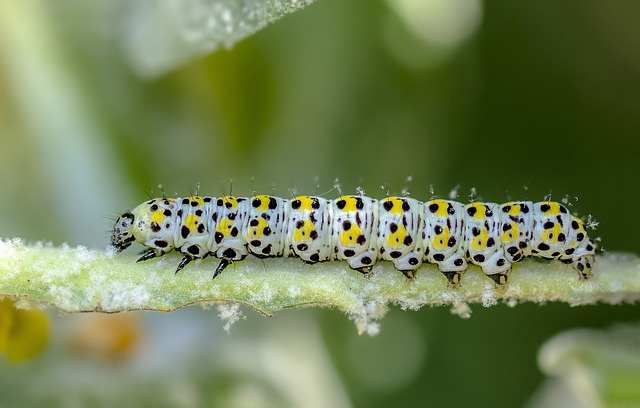
The beautiful mullein moth caterpillar is identified by its white or pale green body with black and yellow spots
The larva of the mullein moth is a pale gray caterpillar with a distinctive pattern of yellow and black spots. The yellow patterning is so pronounced with some species that the larva appears more yellow than bluish-gray. Other features of this colorful caterpillar are its black head, prolegs, front legs, and fine setae.
The mullein moth caterpillar grows 1.73” to 1.88” (44 – 48 mm) long and has a slender cylindrical shape.
Yellow caterpillar identification
The mullein moth caterpillar is easily identifiable due to its eye-catching yellow and black markings on a pale blue to gray body.
- Adult Stage: Transforms into the mullein moth.
- Caterpillar Feeds on: Primarily feeds on mullein plants (Verbascum species).
- Habitat: Common in North America and Europe, often in fields and meadows.
- Stinging: Mullein moth caterpillars do not have stinging spines.
Buff-Tip Moth Caterpillar (Phalera bucephala)
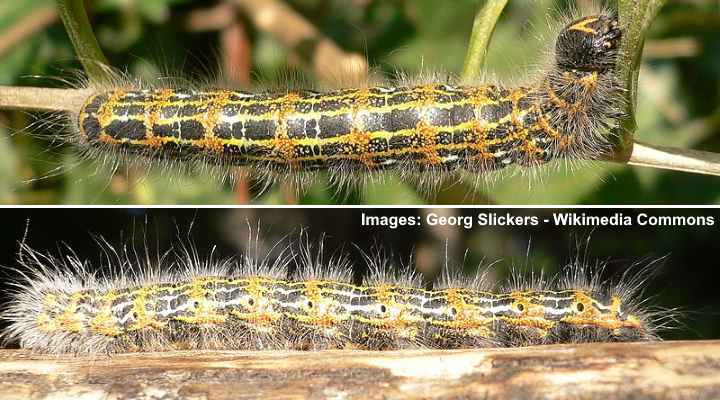
The black body of the buff-tip moth caterpillar has yellow stripes and orange patches and is covered with fine hairs
The buff-tip moth caterpillar is a slender, fuzzy slug-like insect with yellow and black patterns and fine hairs covering its body. The striped patterns on this distinctive caterpillar are yellow or orange bands traversing a black body. However, there are also thin yellow lines running lengthwise. The buff-tip caterpillar grows up to 1.96” (50 mm) long.
Yellow caterpillar identification
Identifying features of the buff-tip caterpillar are its yellow stripes creating black rectangular shapes, fine hairs, and a black head with an orange V-shape.
- Adult Stage: Develops into the buff-tip moth.
- Caterpillar Feeds on: Feeds on deciduous trees and shrubs.
- Habitat: Found in Europe, Asia, and parts of North Africa, often in woodlands.
- Stinging: Buff-tip moth caterpillars do not typically sting.
Yellownecked Caterpillar (Datana ministra)
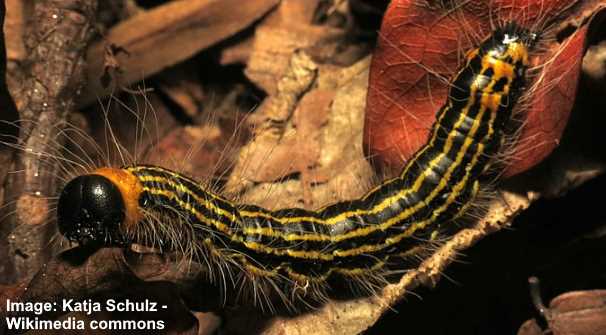
Yellownecked caterpillar (Datana ministra)
The Yellownecked caterpillar has a bright yellow body that is covered with bold black stripes. Its head capsule is typically black, adding to its striking color contrast. The caterpillar has a plump and cylindrical body with small spikes protruding from its segments. These spikes are not venomous but serve as a defensive mechanism against potential predators. When threatened, the Yellownecked caterpillar curls its body into a distinctive “U” shape.
Yellownecked caterpillars typically measure between 1.5 to 2 inches (3.8 to 5 centimeters) in length when fully grown. Their width is roughly proportional to their length, giving them a cylindrical appearance.
You can find Yellownecked caterpillars in various deciduous forests, woodlands, and gardens across North America.
- Adult Stage: Transforms into the yellownecked caterpillar moth.
- Caterpillar Feeds on: Consumes the leaves of deciduous trees, including hickory and walnut.
- Habitat: Common in North America, often in forests and woodlands.
- Stinging: Yellownecked caterpillar larvae may have mildly irritating spines but are not known for severe stings.
Frequently Asked Questions About Yellow Caterpillars
What are the most common yellow caterpillars?
Some of the most common yellow caterpillars include the Woolly Bear caterpillar and the American Dagger Moth caterpillar. However, there are many species with different variations.
What are the most common yellow fuzzy caterpillars?
Two of the most common yellow fuzzy caterpillars are the Woolly Bear caterpillar, which is the larval stage of the Isabella Tiger Moth, and the American Dagger Moth caterpillar. These caterpillars are known for their fuzzy appearance and are often yellow in color. However, keep in mind that there are other species of yellow fuzzy caterpillars as well.
Are all yellow caterpillars fuzzy?
No, not all yellow caterpillars are fuzzy. Fuzziness can vary among caterpillar species. Some are completely covered in fine hairs, while others may have a smoother appearance.
How can I differentiate between different yellow caterpillar species?
Identification can be challenging, but you can look for distinctive features such as body shape, color patterns, the presence of hairs, and head markings. Consult our identification guide for more specific details.
Are yellow caterpillars harmful or dangerous?
Most yellow caterpillars are not harmful to humans, but some may have urticating hairs that can cause skin irritation. It’s best to avoid touching caterpillars you’re not familiar with.
What do yellow caterpillars eat?
Caterpillar diets vary by species. Some may feed on specific plants, while others have a broader range of host plants. Detailed information about the diet of each species can be found in our guide.
How long do yellow caterpillars stay in the larval stage?
The duration of the larval stage varies depending on the species and environmental conditions. It can range from a few weeks to several months.
What should I do if I find a yellow caterpillar in my garden?
If you find a yellow caterpillar in your garden, observe it from a distance, but avoid handling it unless you are sure it’s not harmful. Caterpillars can be beneficial by pollinating plants or serving as food for birds and other wildlife.
Related articles:
- Black Caterpillar Identification and Guide
- Types of Green Caterpillars with Identification Guide
- Stinging and Venomous Caterpillars – Identification Guide

